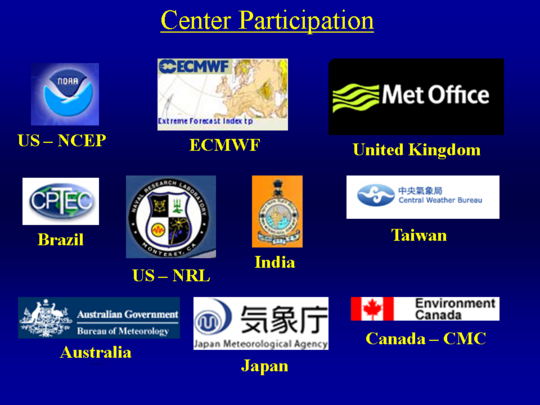|
HOME > Climate & Weather Linkage > Dynamical Model MJO Forecasts
|
Dynamical Model MJO Forecasts
|
The U.S. CLIVAR program instituted a MJO working group to develop diagnostics related to the MJO during 2006. A subgroup was organized to focus on MJO operational prediction and was tasked to develop a MJO forecast metric for comparison of dynamical models from operational global prediction systems. The activity is housed at CPC where the application, display, and evaluation of these MJO model forecasts is being done. In 2010, the group was reformulated as the WCRP/WWRP THORPEX YOTC Task Force. This website will see updates as additional models become available. The products at this site are to be considered EXPERIMENTAL at the current time.
|
|
|
|
A key for the label headings in the figure box is provided below. Click on the headings for additional information for specific model-related information such as the number of ensemble members, forecast duration and climatologies used.
We are in the process of upgrading these plots to provide a more reliable service. The aesthetics of some plots will change over the next several weeks as we roll out the new code base, but the underlying data will be the same. Please send any questions or comments to Nicholas.Novella@noaa.gov. Thank you for your patience.
|
| |
|
Note: Move cursor over product name to display. Click for additional information.
|
|
|
|
|
|
Heading Key:
NCPO: National Centers for Environmental Prediction - Operational Global Forecast System
NCPE: National Centers for Environmental Prediction - Ensemble Global Forecast System
NCPB: National Centers for Environmental Prediction - Bias-Corrected Ensemble Global Forecast System
NCFS: National Centers for Environmental Prediction - Climate Forecast System
UKMA: UK Met Office - MOGREPS-G Operational Control Run
UKME: UK Met Office - MOGREPS-G Ensemble System
CMET: Canadian Meteorology Centre - Ensemble System
ECMF: European Centre for Medium Range Weather Forecasts - Ensemble System
ECMM: European Centre for Medium Range Weather Forecasts - Ensemble System (anomalies based on lead dependent model climatology)
BOMA: Australian Bureau of Meteorology - ACCESS-S1 Ensemble System
BOMM: Australian Bureau of Meteorology - ACCESS-S1 Ensemble System (anomalies based on lead dependent model climatology)
CPTC: Brazil Center for Weather and Climate Studies - Ensemble System
JMAN: Japan Meteorology Agency - Global Spectral Model Ensemble System
TCWB: Taiwan Central Weather Bureau - Operational Prediction System
IMDO: India Meteorology Department - Operational Global Forecast System
EMON: European Centre for Medium Range Weather Forecasts - Seasonal Prediction Ensemble Forecast System
EMOM: European Centre for Medium Range Weather Forecasts - Seasonal Prediction Ensemble Forecast System (anomalies based on lead dependent model climatology, weekly - Thursday only)
|
|
[Back to the Top]
|
- Model Comparison Methodology Specifics
|
|
The methodology for the creation of the phase space plots above follows closely to that described in Wheeler and Hendon (2004) (hereafter WH2004). A notable difference between WH2004 and the procedure employed here is that the linear removal of the ENSO signal (related by the BMRC SST1 index) is not performed. After discussion among the MJOWG members, it was decided that this step was not necessary as the subsequent removal of the 120-day mean is sufficient to remove much of the interannual signal.
|
| |
|
The table below summarizes the data requested by the MJOWG for the operational centers. For additional details regarding the data and methodology, see the document link below the table. This document includes background information and motivation for this activity along with directions for interested operational centers who wish to participate in this project.
|
| |
| Fields |
OLR, u850, and u200 totals (anomaly fields optional)
Initial analysis, forecasts of all ensemble members, out to no more than 40 days
|
| Resolution |
2.5 in longitude (0, 2.5E. 5.0E, Daily averaged (00-24Z)) |
| Update Frequency |
Daily, or less for those systems run at a reduced frequency
Additional data during initial transfer (i.e., send analysis data for past 120 days)
|
| Format |
ASCII |
|
| |
|
Further Information -- Working Group on Numerical experimentation (WGNE) Letter
|
| |
|
[Back to the Top]
|
| |
|
|
|
Various models from participating centers are provided below and include datastreams consisting of a varying number of ensemble members and forecast duration.
|

|
| |
|
[Back to the Top]
|
| |
|
|
|
Wheeler M. and H. Hendon, 2004: An All-Season Real-Time Multivariate MJO Index: Development of an Index for Monitoring and Prediction, Monthly Weather Review, 132, 1917-1932.
|
|
Gottschalck, J., M. Wheeler, K. Weickmann, F. Vitart, N. Savage, H. Lin, H. Hendon, D. Waliser, K. Sperber, M. Nakagawa, C. Prestrelo, M. Faltau, and W. Higgins, 2010: A Framework for Assessing Operational Model MJO Forecasts: A Project of the CLIVAR Madden-Julian Oscillation Working Group. Bull. Amer. Met. Soc., In press.
|
|
Gottschalck, J., M. Wheeler, K. Weickmann, D. Waliser, K. Sperber, F. Vitart, N. Savage, H. Lin, H. Hendon, M. Faltau, 2008: Madden-Julian Oscillation Forecasting at Operational Modelling Centres. CLIVAR Exchanges, 13, October 2008.
|
|
Lin, H., G. Brunet, and J. Derome, 2008: Forecast skill of the Madden-Julian Oscillation in two Canadian atmospheric models. Mon. Wea. Rev., 136, 4130-4149.
|
|
Goswami, B.N., Wheeler, M. C., Gottschalck, J. C. and Waliser, D.E., 2008: Intraseasonal Variability and Forecasting:
A Review of Recent Research. The Fourth International Workshop on Monsoons, IWM-IV, 20-26 October 2008, Beijing, China.
|
|
[Back to the Top]
|
